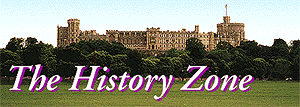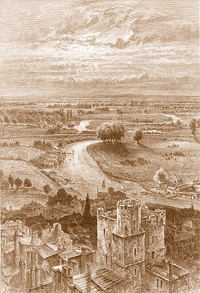 
|
||||
4 The Castle - The Round Tower |
 
|
||||
4 The Castle - The Round Tower |
4 Of the Keep, or Round Tower This Tower, sometimes called the Middle Ward, which forms the west side of the Upper Court, is built in the form of an amphitheatre, on the highest part of the mount; the ascent into the upper apartments is by a flight of 100 stone steps, at the top of which is planted a large piece of cannon, levelled at the entrance, or bottom of these steps; there are likewise 17 pieces of cannon mounted round the curtain of the Tower, which is the only battery now in the Castle, though formerly the whole place was strongly fortified with cannon, on each of the several towers, and two platforms in the lower ward. The apartments of this tower belong to the Constable, or Governor, whose office is both military and civil: as a military officer, he is obliged to defend the Castle against all enemies, whether foreign or domestic. He has the charge of prisoners brought hither, and is accountable to the King for whatever is contained in the Castle. He has a deputy or lieutenant-governor, who holds equal command in his absence, and has lodgings appointed for his residence at the entrance of the tower we are now about to describe. The constable, as a civil officer, is judge of a court of record, held by prescription over the town gate in the lower ward, for the determination of pleas between party and party, within the precincts of Windsor Forest, which comprehends many towns, over which this Court has jurisdiction; and all legal processes, judgements, and executions, are issued in his name; but the practice of this Court is at present suspended. He is likewise Chief Forester and Warden of Windsor Forest, which extends 120 miles in circumference. The entrance into this tower is through a square paved court, in which is a reservoir of water, erected in the reign of Charles II to receive the drains from the upper leads. The court is hung round with buckets, which are there ready in case of fire. In 1784, here was also erected, under the direction of Mr. Grey, an engine for raising water upwards of 370 feet, by the simple contrivance of a rope; the ends of which being spliced together, it is fixed to a wheel and gudgeon in the water, and to a windlass at the top of the well; the windlass being turned with a moderate degree of velocity, the water adheres to the ascending part of the rope, until it arrives at the top; it is then thrown off, and collected by means of a semi-circular cap, that incloses the inner wheel of the windlass; this cap having a spout on one side of it, the water is conducted into any vessel that may be placed to receive it. The first apartment you enter is the Guard ChamberIn this room is a small magazine of arms, curiously disposed, as matchlocks, the first ever made, whole, half, and quarter pikes, with bandoliers of various figures. Round the cornice is a number of breastplates, with helmets over them, and several drums, in proper order. Over the chimney is carved in lime-wood, the star and garter, in the form of an oval, crowned and encompassed with daggers and pistols. The pillars of the door leading to the dining-room are composed of pikes, on the tops of which are two coats of mail, said to be those of John, King of France, and David, King of Scotland, who were prisoners here; they are both inlaid with gold, the former with fleur-de-luces, and the latter with thistles. On the staircase leading to the dining-room, stands the figure of a yeoman of the guard, painted in his proper dress, as if in waiting. Here are four pillars of pikes, ornamented with bandoleers, carbines, and matchlocks. In the centre is a beautiful engraved horse-shield, encompassed with daggers and pistols; as also several of King James's and King William's pieces, ranged by the late Mr. Harris. Dining RoomThe tapestry, which is disposed in six compartments, contains the History of Hero and Leander. Dressing RoomIn this Room are the following Prints and Drawings. There are several other prints in this room, but none that are deserving of particular attention. Bed ChamberHere are six ebony chairs, of a particular make, curiously studded with ivory. The tapestry is wrought with gold and silver, representing the story of Autoclotus, King of Phrygia, and his three daughters, weeping to death by the side of the Helicon. In another part is the story of Pandora's Box; the other parts of the tapestry are likewise representations of Heathen Mythology. The other apartments having nothing in them worthy the attention of a traveller, we shall proceed to the top of the tower, on the leads of which is placed the royal standard, which is fourteen yards long and eight broad, and is hoisted when the Governor is present, provided the King be not here. This tower commands a most delightful and extensive prospect, as the reader will readily conceive from the following inscription, written on a board placed against the wall. It would be superfluous to inform the reader of the many churches, mansions, seats, and remarkable places that are to be seen from these leads, as most of them will naturally occur on reading the above inscription.  illustrates the view to the west that Charles Knight had in mind as he wrote the above description.
Thamesweb are grateful
to Master James (aged 11) for scanning and proof reading the
above from the original typed text prepared by MNC to whom we
are equally indebted.
|
||||||||||||||||||||||||
4 The Castle - The Round Tower |
